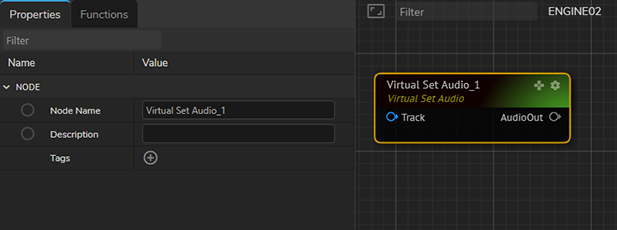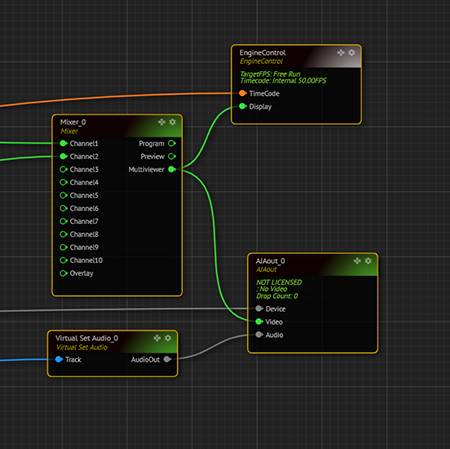Virtual Set Audio
To make the audio in the virtual set actually sound like it should sound in the real world, VIRTUALSETAUDIOnode provides tools to mold the sounds in the virtual set to give them the desired feel. Virtual audio node, which can capture the audio from the Unreal world using a track input to decide where to capture the sound from. Audio from the virtual set will be audible in stereo with determining the virtual camera position in the 3D world and being breathing more life into your production. Let us assume that we have a media file with audio data in the virtual set.
Add the VIRTUAL SET AUDIO node from Media I/O to your compositing pipeline.

The node has 1 input pin (TRACK) and 1 output pin (AUDIOOUT), connect the output from tracking devices TRACK pin to the VIRTUAL SET AUDIO’s TRACK pin and then connect AUDIOOUT from VIRTUAL SET AUDIO’s pin to AJAOUT node’s AUDIO input pin as shown on the image above:

Now to hear the Virtual set sound, you need to position your physical camera close to the area where the audio file is designed in the virtual scene. Remember that virtual set audio is designed to achieve a real-life-like surround sound and hence the camera position will determine the audio intensity level. Once the camera is close to where the audio is, you should be able to hear audio from the AJA card.
The camera zoom level will not affect the audio in the scene, because the actual position of the camera is not moving towards the area where the audio is playing.
Stereo Surround Sound
Reality Engine can produce stereo surround sound just like it would in real life. In accordance with the position of camera movements, the surround sound will be produced. It is determined by the movement of the camera, if the camera pans from left to right, the audio will be heard gradually from the left to right channel as the camera moves along. The same is with the audio levels, as the camera moves towards the position where the audio source is, the audio gradually increases its volume level and decreases as the camera moves farther. It also detects multiple audio sources at different positions in the virtual scene simultaneously and blends with all the available sources as the camera moves through that space.